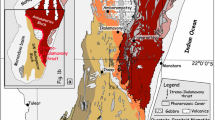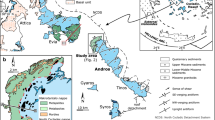Abstract
This contribution discusses the development of the Palaeoproterozoic Buganda-Toro belt in the Rwenzori Mountains and its influence on the western part of the East African Rift System in Uganda. The Buganda-Toro belt is composed of several thick-skinned nappes consisting of Archaean Gneisses and Palaeoproterozoic cover units that are thrusted northwards. The high Rwenzori Mountains are located in the frontal unit of this belt with retrograde greenschist facies gneisses towards the north, which are unconformably overlain by metasediments and amphibolites. Towards the south, the metasediments are overthrust by the next migmatitic gneiss unit that belongs to a crustal-scale nappe. The southwards dipping metasedimentary and volcanic sequence in the high Rwenzori Mountains shows an inverse metamorphic grade with greenschist facies conditions in the north and amphibolite facies conditions in the south. Early D1 deformation structures are overgrown by cordierite, which in turn grows into D2 deformation, representing the major northwards directed thrusting event. We argue that the inverse metamorphic gradient develops because higher grade rocks are exhumed in the footwall of a crustal-scale nappe, whereas the exhumation decreases towards the north away from the nappe leading to a decrease in metamorphic grade. The D2 deformation event is followed by a D3 E-W compression, a D4 with the development of steep shear zones with a NNE-SSW and SSE-NNW trend including the large Nyamwamba shear followed by a local D5 retrograde event and D6 brittle reverse faulting. The Palaeoproterozoic Buganda-Toro belt is relatively stiff and crosses the NNE-SSW running rift system exactly at the node where the highest peaks of the Rwenzori Mountains are situated and where the Lake George rift terminates towards the north. Orientation of brittle and ductile fabrics show some similarities indicating that the cross-cutting Buganda-Toro belt influenced rift propagation and brittle fault development within the Rwenzori Mountains and that this stiff belt may form part of the reason why the Rwenzori Mountains are relatively high within the rift.









Similar content being viewed by others
References
Bailey AI (1969) Report on the geology of the Watamagufu-Bugoye area of the Ruwenzori Mountains. 13th Ann. Rept. Inst. Afr. Geol. Univ. Leeds, pp 13–14
Cahen L, Snelling NJ, Delhal J, Vail JR (1984) The geochronology and evolution of Africa. Clarendon Press, Oxford
Chorowicz J (2005) The East African rift system. J Afr Earth Sci 43(1–3):379–410. doi:10.1016/j.jafrearsci.2005.07.019
De Waele B, Johnson SP, Pisarevsky SA (2008) Paleoproterozoic to Neoproterozoic growth and evolution of the eastern Congo Craton. Its role in the Rodenia puzzle. Precambrian Res 160(2):127–141
Delvaux D, Kervyn F, Macheyeki AS, Temu EB (2012) Geodynamic significance of the TRM segment in the East African Rift (W-Tanzania): active tectonics and paleostress in the Ufipa plateau and Rukwa basin. J Struct Geol 37:161–180
Ebinger CJ (1989) Tectonic development of the western branch of the East African rift system. Geol Soc Am Bull 101(7):885–903, doi:10.1130/0016-7606(1989)1010885:TDOTWB2.3.CO;2
Elliot GFS, Gregory JW (1895) The geology of Mount Ruwenzori and some adjoining regions of equatorial Africa. Quart J Geol Soc 51:669–680
Hepworth JV, Macdonald R (1966) Orogenic belts of the northern Uganda basement. Nature 210:726–727
Koehn D, Aanyu K, Haines S, Sachau T (2008) Rift nucleation, rift propagation and the creation of basement micro-plates within active rifts. Tectonophysics 458:105–116
Koehn D, Lindenfeld M, Ruempker G, Aanyu K, Haines S, Passchier CW, Sachau T (2010) Active transsection faults in rift transfer zones: evidence for complex stress fields and implications for crustal fragmentation processes in the western branch of the East African Rift. Int J Earth Sci 99(7):1633–1642. doi:10.1007/s00531-010-0525-2
Leggo PJ (1974) A geochronological study of the basement complex of Uganda. J Geol Soc Lond 130:263–277
Lindenfeld M, Ruempker G, Link K, Koehn D, Batte A (2012) Fluid-triggered earthquake swarms in the Rwenzori region, East African Rift—Evidence for rift initiation. Tectonophysics 566–567:95–104. doi:10.1016/j.tecto.2012.07.010
Link K, Koehn D, Barth MG, Tiberindwa JV, Barifaijo E, Aanyu K, Foley SF (2010) Continuous cratonic crust between the Congo and Tanzania blocks in western Uganda. Int J Earth Sci 99(7):1559–1573. doi:10.1007/s00531-010-0548-8
MacDonald R (1966) Geological map of Uganda. Department of Geological Survey and Mines, Uganda
Mazimhaka PK (1973) Report on a study of part of the eastern deposit at Kilembe mines Limited.Unpubl. Econ. Geol. Proj. Rept. 1–33, Kampala
McConnell RB (1959) Outline of the geology of the Ruwenzori 564 Mountains. Overseas Geol Miner Resour 7(245–268):565
McConnell RB (1972) Geological development of the rift system of eastern Africa. Geol Soc Am Bull 83(9):2549–2572. doi:10.1130/0016-7606(1972)83[2549:GDOTRS]2.0.CO;2
Morley CK (1999) Geoscience of rift systems-evolution of East 568 Africa. AAPG stud geol 44:242
Passchier CW, Trouw R (2005) Microtectonics. Springer, Berlin
Ring U (2008) Extreme uplift of the Rwenzori Mountains in the East African rift, Uganda: structural framework and possible role of glaciations. Tectonics 27: TC4018, doi:10.1029/2007TC002176
Sachau T, Koehn D, Passchier CW (2013) Mountain-building under extension. Am J Sci 313(4):326–344
Schlueter T, Traut M (2008) Geological Atlas of Africa. Springer, Berlin 320 pp
Stamps DS, Calais E, Saria E, Hartnady C, Nocquet JM, Ebinger CJ, Fernandes RM (2008) A kinematic model for the East African rift. Geophys Res Lett 35:L05304
Stern RJ (1994) Arc assembly and continental collision in the neoproterozoic east African orogen: implications the consolida- tion of Gondwanaland. Annu Rev Earth Sci 22:319–351
Tanner PWG (1970) The Ruwenzori fold belt of east Africa. Ann Rep Res Inst. African Geology University Leeds, 14:3–7
Tanner PWG (1973) Regional metamorphism of low pressure intermediate type in the Ruwenzori fold belt of East Africa. Ann. Rept. Res. Inst. Afr. Geol., Univ. Leeds 17, 20–26
Warden AJ (1985) Reappraisal of the geological setting and potential of Kilembe copper mine, Uganda Trans. Instn. Min. Metall., Section B, B94–B105
Westerhof ABP, Haermae P, Isabirye E, Katto E, Koistinen T, Kuosmanen E, Lehto T, Lehtonen MI, Maekitie H, Manninen T, Maenttaeri I, Pekkala Y, Pikki J, Saalmann K, Virransalo P (2014) Geology and geodynamic development of Uganda with explanation of the 1:1,000,000: scale geological map. Geol Surv Finland, Special Paper 55
Wölbern I, Rümpker G, Schumann A, Muwanga A (2010) Crustal thinning beneath the Rwenzori region, Albertine rift, Uganda, from receiver-function analysis. Int J Earth Sci 99:1545–1557
Acknowledgments
We are very grateful for the suggestions of the reviewers Ruediger Killian and Enrique Gomez Rivas, which significantly enhanced the quality of the manuscript. We acknowledge funding of our research by DFG Grant KO 2463/4-2 of the Forschergruppe “Rift Dynamics, uplift and climate change in Equatorial Africa.” we thank the Uganda Wildlife Authority for their permission to work in the parks and the Ugandan National Council of Science and Technology. We acknowledge the use of the program Stereonet 6.3.2 from R.W. Allmendinger.
Author information
Authors and Affiliations
Corresponding author
Rights and permissions
About this article
Cite this article
Koehn, D., Link, K., Sachau, T. et al. The Rwenzori Mountains, a Palaeoproterozoic crustal shear belt crossing the Albertine rift system. Int J Earth Sci (Geol Rundsch) 105, 1693–1705 (2016). https://doi.org/10.1007/s00531-015-1167-1
Received:
Accepted:
Published:
Issue Date:
DOI: https://doi.org/10.1007/s00531-015-1167-1




